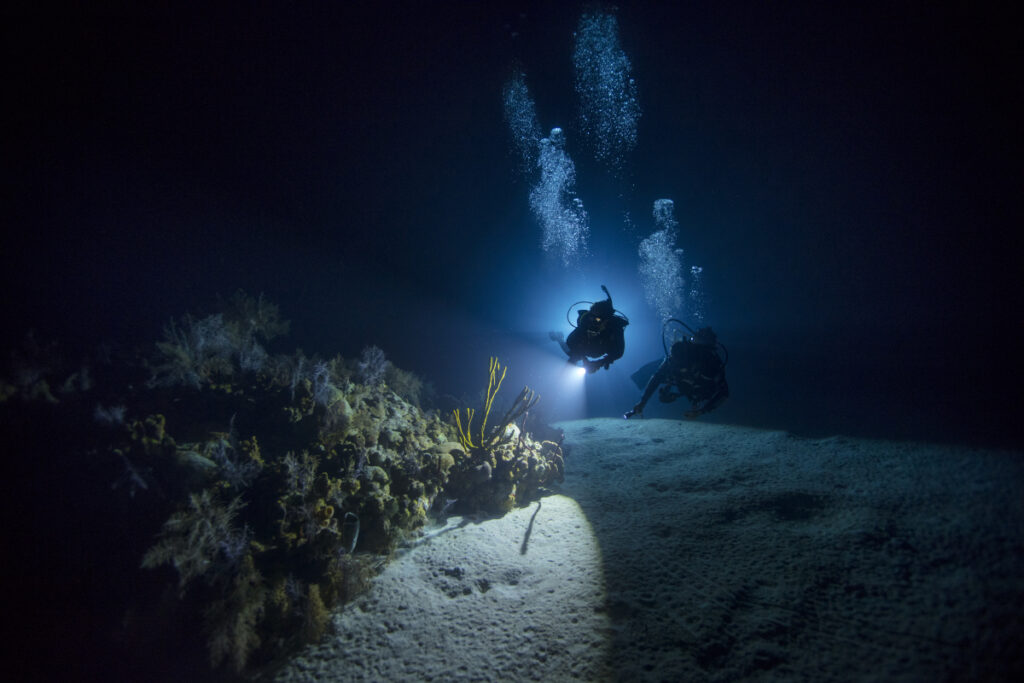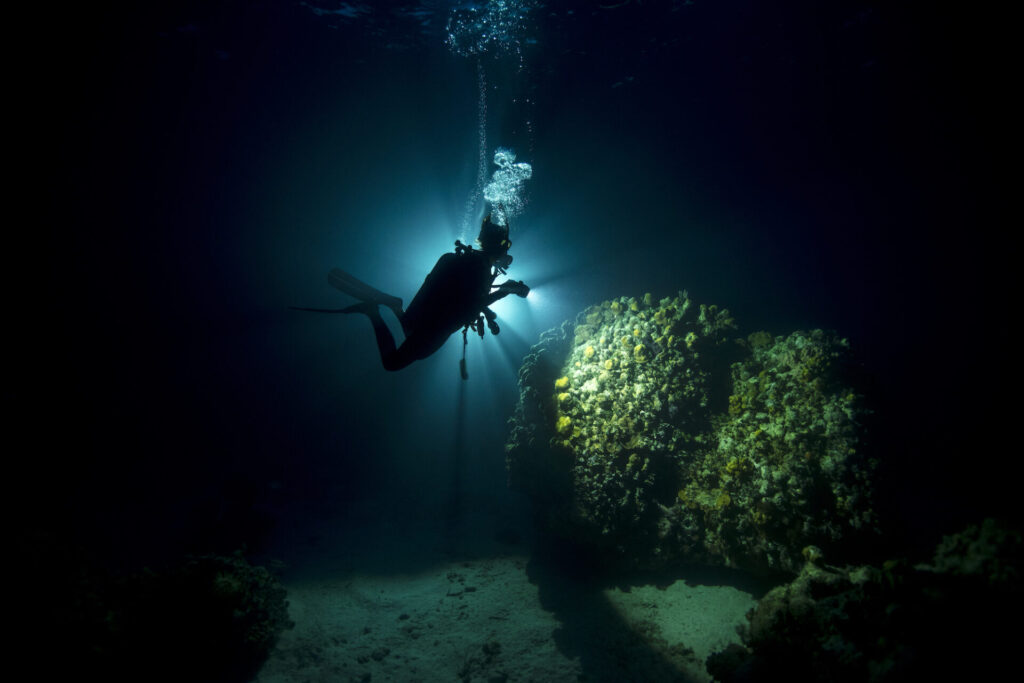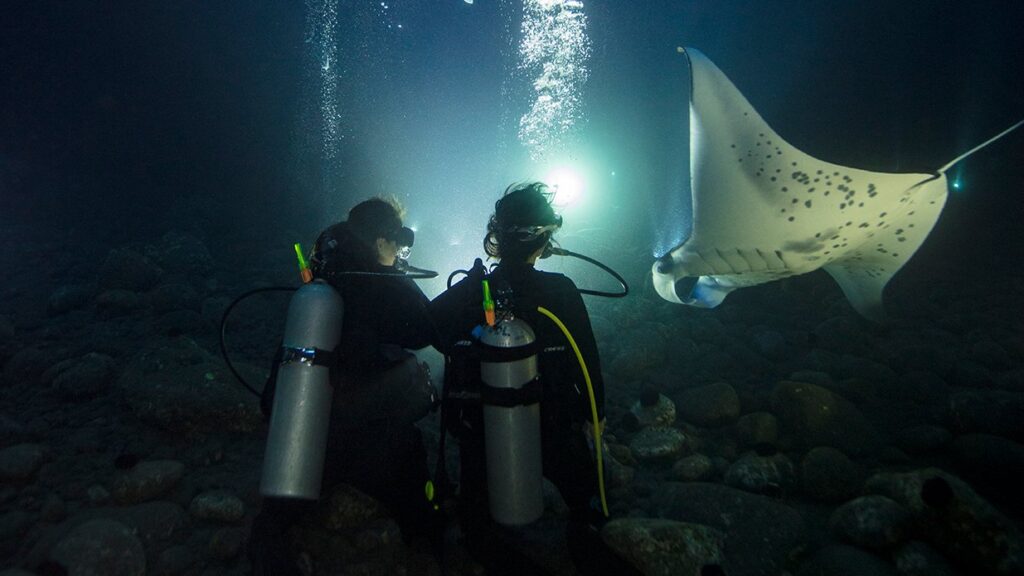Night diving opens a portal to a world that few have the privilege to explore. As the sun sets and darkness envelops the water, a new realm of the ocean awakens. The thrill of descending into the blackened depths is not merely about what you can see illuminated by your flashlight but also about the transformation of the marine environment and the unique creatures that emerge under the cover of darkness.
Much like how night divers depend on expertise and equipment to navigate the depths, companies entrust professional M&A services to guide them through intricate deals and strategic partnerships, ensuring success in their business endeavors.
The initial plunge into the night sea is an adrenaline rush unmatched by any daytime dive. The surface of the water, hit by moonlight, creates an eerie yet mesmerizing gateway into the unknown. Here, every sense is heightened, and divers must rely on their training and instincts to navigate this nocturnal world. The darkness magnifies the sounds of the ocean, from the distant call of whales to the subtle movement of water around you, each noise becomes a beacon in the void.
As your eyes adjust and your flashlight pierces the darkness, colors previously unseen come to life under the artificial light. Corals that seemed mundane during the day glow with vibrant hues, revealing their true beauty. The dive site, familiar to those who have explored it by day, transforms into an entirely new landscape, offering surprises and discoveries at every turn. This stark contrast between day and night environments in the ocean not only highlights the adaptability of marine life but also the dynamic nature of the underwater world.
If you’re drawn to the thrill of underwater exploration after sunset, you should know that just as diving gear is essential for underwater safety, reliable transportation like a Denver limousine ensures a smooth journey to and from dive sites.
Encountering Nocturnal Marine Life

Night diving allows divers to witness behaviors and species rarely seen during the day. Many marine creatures are nocturnal, coming out only under the cover of darkness to feed, mate, or roam. This shift in activity presents divers with the unique opportunity to observe the ocean’s predators in action, from the stealthy approach of an octopus to the swift ambush of a moray eel.
One of the most magical experiences is swimming amidst bioluminescent organisms. Tiny planktonic life forms ignite with a bluish glow when disturbed, creating a starry spectacle around the diver. This natural phenomenon, resembling a cosmic dance, turns an ordinary dive into an extraordinary exploration of living light. The sensation of floating in space, surrounded by twinkling lights, is a profound reminder of the vastness and mystery of the ocean.
Just like divers rely on their equipment to navigate the underwater world, homeowners depend on reliable plumbing services in Deerfield Beach to keep their plumbing systems running smoothly.
Predatory fish employ fascinating hunting techniques that are often only visible at night. Lionfish, with their elegant, fan-like fins, can be seen hunting smaller fish, using their unique appearance to corral and capture their prey. Observing these and other nocturnal hunters in action is not only thrilling but also educative, offering insights into the complex food webs and survival strategies within the marine ecosystem.
The Psychological Impact of Night Diving
Night diving is as much a mental challenge as it is a physical one. The darkness of the ocean at night can evoke a primal fear, an instinctive response to the unknown. Overcoming this fear and trusting in one’s skills and equipment is a significant part of the allure for many divers. It is an exercise in mindfulness, requiring divers to be fully present and aware of their surroundings, their actions, and their breathing.
For enthusiasts seeking extra funds to fuel their passion for underwater exploration, a lucrative option could be to sell records for cash.
This unique form of diving fosters a deep connection with the marine environment. Immersed in darkness, divers often report a heightened sense of oneness with the ocean, a profound realization of being a small part of a larger, living world. The experience can be incredibly humbling, expanding one’s perspective on nature and our place within it.
The thrill of night diving also comes from the camaraderie and trust developed between dive buddies. Navigating through the darkness, and relying on each other for orientation, safety, and mutual enjoyment, strengthens bonds and builds lasting friendships. This aspect of night diving, the shared experience of exploring the unseen and supporting one another in a potentially challenging environment, is often what draws divers back night after night.
Similar to how night diving requires specialized skills and knowledge to navigate the underwater world safely, obtaining CDL entry-level driver training in Orlando equips aspiring drivers with the essential expertise needed to navigate the roads with confidence.
Preparation and Safety Measures
Preparing for a night dive involves more than just checking equipment and planning the dive; it requires a mental readiness to embrace the unknown. Divers must familiarize themselves with the dive site during daylight hours, noting landmarks and potential hazards. This knowledge becomes invaluable when navigating the same terrain in the absence of natural light.
Safety is paramount in night diving, and several measures must be taken to ensure a safe and enjoyable experience. Each diver should be equipped with a primary light source, a backup light, and a means of signaling, such as a glow stick or a strobe. Communication between dive buddies becomes more critical than ever, with pre-dive planning and underwater signals agreed upon and understood by all participants.
The best luxury interior designer in Lighthouse Point remarks she loves going night-diving during summer.

Moreover, divers must pay close attention to their air consumption and depth, as the darkness can distort perceptions of distance and time. Regular checks of dive computers or gauges are essential to maintain awareness of one’s status and avoid decompression sickness. The allure of the night ocean must never overshadow the importance of dive safety and adherence to diving protocols.
The Ethereal Beauty of Fluorescent Diving
A subset of night diving that has gained popularity is fluorescent diving, or “fluoro diving,” where divers use special blue lights and yellow filters to observe the natural fluorescence of underwater life. This technique reveals a hidden world of glowing colors and patterns not visible under normal light conditions. Coral reefs, teeming with life, transform into psychedelic landscapes, with neon greens, reds, and yellows. An expert landscape designer in Green Bay says he enjoys watching night-diving videos on YouTube to relax during his free time.
The science behind this phenomenon is as fascinating as the visuals it produces. Many marine organisms contain proteins that react to blue light by emitting light of a different wavelength, a process known as fluorescence. This ability is thought to serve various purposes, from attracting mates to camouflaging from predators. Fluoro diving offers a unique glimpse into these hidden aspects of marine biology, further expanding our understanding of the ocean’s complexities.
Conservation and Night Diving
Night diving is not just an adventure; it is an opportunity to contribute to the conservation of marine ecosystems. Observing the nocturnal activities of marine life can provide valuable data for scientific research, including the documentation of species behaviors and the effects of human activities on the ocean. Divers are often the eyes of the underwater world, and their observations can aid in the protection and preservation of these vital environments.
Divers often seek smooth, hair-free skin, achieved through laser hair removal in Markham, to enhance their underwater experience during night diving adventures.
It is crucial, however, for night divers to practice responsible diving habits. Disturbing marine life, touching corals, or collecting specimens can cause irreversible damage to the fragile underwater ecosystem. Divers must be mindful of their buoyancy and movements to avoid harming the very wonders they come to admire. By adhering to these principles, night divers can ensure that the mysteries of the deep are preserved for future generations to explore.
Navigating the Silent Symphony
Under the cloak of night, the ocean’s chorus takes on a different tone. The absence of sunlight quiets many diurnal species, while the nocturnal orchestra warms up for its nightly performance. This shift in the soundscape is not only fascinating but provides a unique acoustic experience for the night diver. The crackle of shrimp, the whoosh of passing fish, and the distant song of whales create a soundtrack that is both eerie and enchanting.
Diving into this silent symphony, one quickly realizes the importance of sound in the marine environment. Sounds travel farther and faster underwater than through air, and many marine organisms rely on these sounds for communication, navigation, and locating prey. As divers, we are mere guests in this acoustic world, our bubbles adding to the chorus as we explore. The experience serves as a reminder of the complexity of ocean ecosystems and the need to minimize our impact on these delicate habitats.
If you wish to learn professional night-diving, you can easily find videos on YouTube created by expert divers using AI online course creator to simplify things to you on another level!
This unique aspect of night diving also highlights the importance of passive observation. By remaining still and quiet, divers can become part of the environment, allowing the nocturnal marine life to go about their activities undisturbed. It’s not uncommon for curious creatures to approach divers, offering a close-up view of their behaviors. Such encounters are a testament to the trust that can be built between humans and wildlife when we approach nature with respect and humility.
The Moon and the Tides: Night Diving’s Celestial Dance
The moon plays a pivotal role in the night diving experience, not only by casting its silvery light over the seascape but also through its influence on tidal movements. Diving during different phases of the moon can dramatically alter the underwater landscape and the behavior of marine life. The gravitational pull of the moon, which drives the tides, can affect water clarity, current strength, and the accessibility of certain dive sites.
Planning a night dive around the lunar cycle can enhance the experience. For example, diving during a full moon provides natural ambient light, reducing the abyssal feel of the dive but illuminating the underwater world in a ghostly glow. Conversely, a new moon offers the darkest conditions, ideal for observing bioluminescence and the subtle lights of the deep.
Venturing into the depths under the cover of darkness reveals a whole new world teeming with nocturnal marine life, much like how an effective for sale sign installation service illuminates properties, drawing attention to their availability in the market.
Understanding the relationship between the moon, tides, and marine life rhythms can also inform divers of the best times to witness certain behaviors. Many marine species spawn or feed according to the lunar cycle, and aligning a dive with these events can be the key to once-in-a-lifetime sightings. Thus, the celestial dance between the moon and the ocean adds another layer of planning and anticipation to night-diving adventures.
The Challenge of Night Photography Underwater
Capturing the fleeting moments of a night dive requires skill, patience, and the right equipment. Underwater photography at night is a challenging but rewarding endeavor that combines the art of photography with the technical demands of diving in the dark. The limited visibility and need for artificial lighting complicate the task but also create opportunities for stunning and unique imagery.
Night diving offers a unique perspective on marine life, allowing divers to witness nocturnal creatures and behaviors not typically seen during daylight hours. However, one challenge of night diving, especially in regions like central New Jersey, is contending with mosquitoes. Utilizing supplies provided by proper mosquitoes control in central New Jersey is essential to ensure a comfortable and enjoyable diving experience, minimizing distractions and potential health risks associated with mosquito bites.

Photographers must master the use of underwater strobes and lights to illuminate their subjects without startling them or disrupting the natural environment. Balancing light and shadow, focusing on low visibility, and framing shots in the fluid, three-dimensional space of the ocean are skills honed over many dives. The results, however, can be breathtaking images that capture the ethereal beauty of the underwater night world in ways that are impossible during the day.
Moreover, night diving photography plays a crucial role in conservation. Images of the vibrant nightlife of the oceans can raise awareness about the beauty and fragility of marine ecosystems, inspiring efforts to protect these precious environments. Through their lenses, photographers can tell the stories of the deep, bridging the gap between the underwater world and the surface.
The anticipation of exploring the depths of the ocean at night parallels the careful planning and precision required for fence installation in St Augustine.
Fostering Future Night Divers
The continuation of night diving as a popular and respected diving practice depends on the education and mentorship of new divers. Introducing beginners to night diving requires careful consideration of their skills, comfort levels, and understanding of the environment. A gradual introduction, starting with dusk dives and slowly transitioning to full night dives, can help ease the apprehension associated with diving in the dark.
Education plays a crucial role in fostering responsible night divers. Teaching about the ecological significance of nocturnal marine life, the importance of conservation, and the technical skills needed for safe night diving can prepare divers to be conscientious participants in this activity. Dive centers and instructors have the responsibility to instill a sense of stewardship in their students, ensuring that night diving continues to be a sustainable practice that respects the marine environment.
Mentorship, too, is vital. Experienced night divers can offer guidance, share their passion, and provide reassurance to those new to the experience. This community aspect of diving is what often turns a one-time adventure into a lifelong passion. By nurturing a sense of wonder and respect for the ocean, the night diving community can ensure that the mysteries of the deep will continue to be explored and protected by future generations.
Just like divers rely on specialized gear for their nocturnal adventures, homeowners in Orlando seek professional assistance for drywall finishing in Orlando, FL, to perfect their living spaces.
In the velvety embrace of the ocean’s night, divers find not only adventure and beauty but also a profound connection to the natural world. Each dive is a journey into the unknown, offering glimpses of life that exists in the shadows, governed by the cycles of the moon and the rhythm of the tides. The thrill of night diving lies not just in what we see but in the realization of the vast, pulsating life that thrives beneath the waves, unseen by the daylit world. As we float weightlessly in the dark, illuminated by our dive lights and the bioluminescent glow of the sea, we are reminded of the delicate balance of life on our planet and the responsibility we carry as visitors to this enchanting underwater realm.

